Grape


Agrapeis afruit,botanically a berry,of thedeciduouswoodyvinesof the flowering plant genusVitis.Grapes are a non-climacterictype of fruit, generally occurring in clusters.
The cultivation of grapes began perhaps 8,000 years ago, and the fruit has been used as human food over history. Eaten fresh or in dried form (asraisins,currantsandsultanas), grapes also hold cultural significance in many parts of the world, particularly for their role inwinemaking.Other grape-derived products include various types of jam, juice, vinegar and oil.
| Nutritional value per 100 g (3.5 oz) | |
|---|---|
| Energy | 288 kJ (69 kcal) |
18.1 g | |
| Sugars | 15.48 g |
| Dietary fiber | 0.9 g |
0.16 g | |
0.72 g | |
| Vitamins | Quantity %DV† |
| Thiamine (B1) | 6% 0.069 mg |
| Riboflavin (B2) | 5% 0.07 mg |
| Niacin (B3) | 1% 0.188 mg |
| Pantothenic acid (B5) | 1% 0.05 mg |
| Vitamin B6 | 5% 0.086 mg |
| Folate (B9) | 1% 2 μg |
| Choline | 1% 5.6 mg |
| Vitamin C | 4% 3.2 mg |
| Vitamin E | 1% 0.19 mg |
| Vitamin K | 12% 14.6 μg |
| Minerals | Quantity %DV† |
| Calcium | 1% 10 mg |
| Iron | 2% 0.36 mg |
| Magnesium | 2% 7 mg |
| Manganese | 3% 0.071 mg |
| Phosphorus | 2% 20 mg |
| Potassium | 6% 191 mg |
| Sodium | 0% 2 mg |
| Zinc | 1% 0.07 mg |
| Other constituents | Quantity |
| Water | 81 g |
| †Percentages estimated usingUS recommendationsfor adults,[1]except for potassium, which is estimated based on expert recommendation fromthe National Academies.[2] | |
History
TheMiddle Eastis generally described as the homeland of grapes and the cultivation of this plant began there 6,000–8,000 years ago.[3][4]Yeast,one of the earliest domesticatedmicroorganisms,occurs naturally on the skins of grapes, leading to the discovery of alcoholic drinks such as wine. The earliest archeological evidence for a dominant position of wine-making in human culture dates from 8,000 years ago inGeorgia.[5][6][7]
Theoldest known winerywas found inArmenia,dating to around 4000 BC.[8]By the 9th century AD, the city ofShirazwas known to produce some of the finest wines in the Middle East. Thus it has been proposed thatSyrahred wine is named afterShiraz,a city in Persia where the grape was used to makeShirazi wine.[9]
Ancient Egyptianhieroglyphicsrecord the cultivation of purple grapes, and history attests to the ancientGreeks,Cypriots,Phoenicians,andRomansgrowing purple grapes both for eating and wine production.[10]The growing of grapes would later spread to other regions in Europe, as well as North Africa, and eventually inNorth America.
In 2005, a team of archaeologists concluded that someChalcolithicwine jars, which were discovered in Cyprus in the 1930s, were the oldest of their kind in the world, dating back to 3,500 BC.[11]Moreover, Commandaria, a sweet dessert wine from Cyprus, is the oldest manufactured wine in the world, its origins traced as far back as 2000 BC.[12]
In North America, native grapes belonging to various species of the genusVitisproliferate in the wild across the continent, and were a part of the diet of manyNative Americans,but were considered by early European colonists to be unsuitable for wine. In the 19th century,Ephraim BullofConcord, Massachusetts,cultivated seeds from wildVitis labruscavines to create theConcord grapewhich would become an important agricultural crop in the United States.[13]
Description
Grapes are a type offruitthat grow in clusters of 15 to 300, and can be crimson, black, dark blue, yellow, green, orange, and pink. "White" grapes are actually green in color, and are evolutionarily derived from the purple grape.Mutationsin tworegulatory genesof white grapes turn off production ofanthocyanins,which are responsible for the color of purple grapes.[14]Anthocyanins and otherpigmentchemicals of the larger family ofpolyphenolsin purple grapes are responsible for the varying shades of purple in red wines.[15][16]Grapes are typically an ellipsoid shape resembling aprolate spheroid.
Nutrition
Raw grapes are 81% water, 18%carbohydrates,1%protein,and have negligiblefat(table). A100-gram (3+1⁄2-ounce) reference amount of raw grapes supplies 288 kilojoules (69 kilocalories) offood energyand a moderate amount ofvitamin K(14% of theDaily Value), with no othermicronutrientsin significant amounts.
Grapevines

Most domesticated grapes come fromcultivarsofVitis vinifera,a grapevine native to the Mediterranean and Central Asia. Minor amounts of fruit and wine come from American and Asian species such as:
- Vitis amurensis,the most important Asian species
- Vitis labrusca,the North American table and grape juice grapevines (including theConcordcultivar), sometimes used for wine, are native to the Eastern United States and Canada.
- Vitis mustangensis(the mustang grape), found in Mississippi, Alabama, Louisiana, Texas, and Oklahoma
- Vitis riparia,a wild vine of North America, is sometimes used for winemaking and for jam. It is native to the entire Eastern United States and north toQuebec.
- Vitis rotundifolia(the muscadine), used for jams and wine, is native to the Southeastern United States fromDelawareto theGulf of Mexico.
Trade
| Rank | Country | 2017 | 2018 | 2019 | 2020 | 2021 |
|---|---|---|---|---|---|---|
| 1 | Peru | 673.4M | 847.3M | 917.9M | 1.0B | 1.5B |
| 2 | Chile | 1.2B | 1.2B | 1.2B | 1.0B | 927.1M |
| 3 | Netherlands | 653.3M | 778.1M | 721.8M | 794.5M | 916.5M |
| 4 | South Africa | 572.0M | 567.4M | 553.4M | 567.2M | 907.3M |
| 5 | Italy | 864.8M | 800.1M | 724.8M | 835.1M | 876.7M |
| 6 | United States | 904.9M | 926.6M | 857.2M | 825.2M | 782.7M |
| 7 | China | 735.4M | 690.1M | 987.4M | 1.2B | 757.3M |
| 8 | Spain | 338.4M | 410.9M | 343.6M | 471.6M | 516.8M |
| 9 | Australia | 286.4M | 286.9M | 386.5M | 432.2M | 344.5M |
| 10 | India | 281.7M | 279.2M | 320.1M | 295.9M | 336.4M |
| - | World | 8.5B | 8.7B | 9.0B | 9.5B | 9.9B |
| Source:Tridge | ||||||
Distribution and production
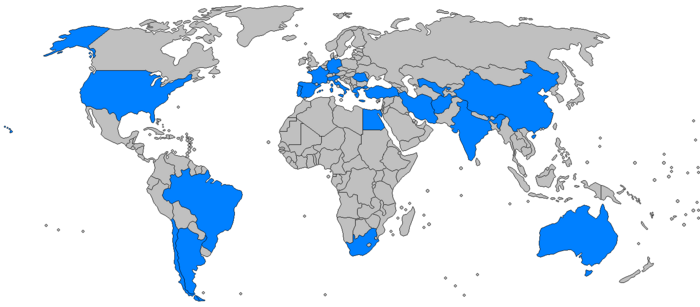
According to theFood and Agriculture Organization(FAO), 75,866 square kilometers of the world are dedicated to grapes. Approximately 71% of world grape production is used for wine, 27% as fresh fruit, and 2% asdried fruit.A portion of grape production goes to producing grape juice to be reconstituted for fruits canned "with noadded sugar"and" 100% natural ". The area dedicated to vineyards is increasing by about 2% per year.
There are no reliable statistics that break down grape production by variety. It is believed that the most widely planted variety isSultana,also known as Thompson Seedless, with at least 3,600 km2(880,000 acres) dedicated to it. The second most common variety isAirén.Other popular varieties includeCabernet Sauvignon,Sauvignon blanc,Cabernet Franc,Merlot,Grenache,Tempranillo,Riesling,andChardonnay.[18]
| Country | Area (km2) |
|---|---|
| 11,750 | |
| 8,640 | |
| 8,270 | |
| 8,120 | |
| 4,150 | |
| 2,860 | |
| 2,480 | |
| 2,160 | |
| 2,080 | |
| 1,840 | |
| 1,642 | |
| 1,459 |
| Rank | Country | 2009 | 2010 | 2011 | 2012 | 2020 |
|---|---|---|---|---|---|---|
| 1 | 8,038,703 | 8,651,831 | 9,174,280 | 9,600,000 F | 14,769,088 | |
| 2 | 6,629,198 | 6,777,731 | 6,756,449 | 6,661,820 | 8,222,360 | |
| 3 | 8,242,500 | 7,787,800 | 7,115,500 | 5,819,010 | 6,817,770 | |
| 4 | 6,101,525 | 5,794,433 | 6,588,904 | 5,338,512 | 5,884,230 | |
| 5 | 5,535,333 | 6,107,617 | 5,809,315 | 5,238,300 | 5,388,679 | |
| 6 | 4,264,720 | 4,255,000 | 4,296,351 | 4,275,659 | 4,208,908 | |
| 7 | 2,600,000 | 2,903,000 | 3,149,380 | 3,200,000 F | 3,125,000 | |
| 8 | 2,181,567 | 2,616,613 | 2,750,000 | 2,800,000 F | 2,772,561 | |
| 9 | 2,305,000 | 2,225,000 | 2,240,000 | 2,150,000 F | 2,055,746 | |
| 10 | 1,748,590 | 1,743,496 | 1,683,927 | 1,839,030 | 2,028,185 | |
| — | World | 58,521,410 | 58,292,101 | 58,500,118 | 67,067,128 | 78,034,332 |
Table and wine grapes
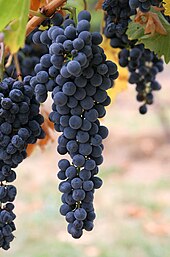
Commercially cultivated grapes can usually be classified as eithertableor wine grapes, based on their intended method of consumption: eaten raw (table grapes) or used to makewine(wine grapes). The sweetness of grapes depends on when they are harvested, as they do not continue to ripen once picked.[21]While almost all of them belong to the same species,Vitis vinifera,table and wine grapes have significant differences, brought about throughselective breeding.Table grape cultivars tend to have large, seedless fruit (see below) with relatively thin skin. Wine grapes are smaller, usually seeded, and have relatively thick skins (a desirable characteristic in winemaking, since much of the aroma in wine comes from the skin). Wine grapes also tend to be very sweet: they are harvested at the time when their juice is approximately 24% sugar by weight. By comparison, commercially produced "100% grape juice", made from table grapes, is usually around 15% sugar by weight.[22]
Seedless grapes
Seedless cultivars now make up the overwhelming majority of table grape plantings. Because grapevines arevegetatively propagatedby cuttings, the lack of seeds does not present a problem for reproduction. It is an issue for breeders, who must either use a seeded variety as the female parent or rescue embryos early in development usingtissue culturetechniques.
There are several sources of the seedlessness trait, and essentially all commercial cultivators get it from one of three sources:Thompson Seedless,Russian Seedless,andBlack Monukka,all being cultivars ofVitis vinifera.There are currently more than a dozen varieties of seedless grapes. Several, such as Einset Seedless, Benjamin Gunnels's Prime seedless grapes, Reliance, and Venus, have been specifically cultivated for hardiness and quality in the relatively cold climates of northeastern United States and southernOntario.[23]
An offset to the improved eating quality of seedlessness is the loss of potential health benefits provided by the enrichedphytochemicalcontent of grape seeds (seeHealth claims,below).[24][25]
Uses
Culinary
Grapes are eaten raw, dried (as raisins, currants and sultanas), or cooked. Also, depending on grape cultivar, grapes are used in winemaking. Grapes can be processed into a multitude of products such as jams, juices, vinegars and oils. Commercially cultivated grapes are classified as either table or wine grapes. These categories are based on their intended method of consumption: grapes that are eaten raw (table grapes), or grapes that are used to make wine (wine grapes). Table grape cultivars normally have large, seedless fruit and thin skins. Wine grapes are smaller (in comparison to table grapes), usually contains seeds, and have thicker skins (a desirable characteristic in making wine). Most of the aroma in wine is from the skin. Wine grapes tend to have a high sugar content. They are harvested at peak sugar levels (approximately 24% sugar by weight.) In comparison, commercially produced "100% grape juice" made from table grapes are normally around 15% sugar by weight.[22]
Raisins, currants and sultanas
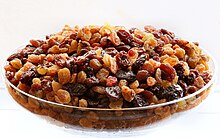
In most of Europe and North America, dried grapes are referred to as "raisins" or the local equivalent. In the UK, three different varieties are recognized, forcing the EU to use the term "dried vine fruit" in official documents.
Araisinis any dried grape. Whileraisinis a Frenchloanword,the word in French refers to the fresh fruit;grappe(from which the Englishgrapeis derived) refers to the bunch (as inune grappe de raisins). A raisin in French is calledraisin sec( "dry grape" ).
Acurrantis a driedZanteBlack Corinth grape, the name being a corruption of the Frenchraisin de Corinthe(Corinthgrape). The names of the black and red currant, now more usuallyblackcurrantandredcurrant,two berries unrelated to grapes, are derived from this use. Some other fruits of similar appearance are also so named, for example, Australian currant, native currant, Indian currant.[26]
Asultanawas originally a raisin made fromSultana grapesof Turkish origin (known as Thompson Seedless in the United States), but the word is now applied to raisins made from either white grapes or red grapes that are bleached to resemble the traditional sultana.
Juice
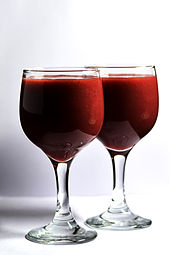
Grape juice is obtained from crushing and blending grapes into a liquid. The juice is often sold in stores orfermentedand made intowine,brandy,orvinegar.Grape juice that has been pasteurized, removing any naturally occurring yeast, will not ferment if kept sterile, and thus contains no alcohol. In thewineindustry, grape juice that contains 7–23% of pulp, skins, stems and seeds is often referred to as "must".In North America, the most common grape juice is purple and made fromConcord grapes,while white grape juice is commonly made fromNiagara grapes,both of which are varieties of native American grapes, a different species from European wine grapes. In California, Sultana (known there as Thompson Seedless) grapes are sometimes diverted from the raisin or table market to produce white juice.[27]
Pomace and phytochemicals
Winemaking from red and white grape flesh and skins produces substantial quantities of organic residues, collectively calledpomace(also "marc" ), which includes crushed skins, seeds, stems, and leaves generally used ascompost.[28]Grape pomace – some 10-30% of the total mass of grapes crushed – contains variousphytochemicals,such as unfermented sugars, alcohol,polyphenols,tannins,anthocyanins,and numerous other compounds, some of which are harvested andextractedfor commercial applications (a process sometimes called "valorization" of the pomace).[28][29]
Skin
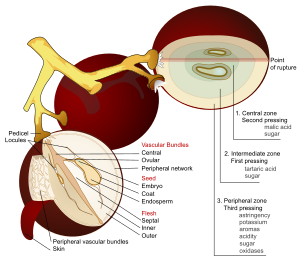
Anthocyaninstend to be the mainpolyphenolicsin purple grapes, whereasflavan-3-ols(i.e.catechins) are the more abundant class of polyphenols in white varieties.[30]Total phenolic content is higher in purple varieties due almost entirely to anthocyanin density in purple grape skin compared to absence of anthocyanins in white grape skin.[30]Phenolic content of grape skin varies withcultivar,soil composition, climate, geographic origin, and cultivation practices or exposure to diseases, such as fungal infections.
Muscadinegrapes contain a relatively high phenolic content among dark grapes.[31][32]In muscadine skins,ellagic acid,myricetin,quercetin,kaempferol,and trans-resveratrol are major phenolics.[33]
The flavonolssyringetin,syringetin 3-O-galactoside,laricitrinand laricitrin 3-O-galactoside are also found in purple grape but absent in white grape.[34]
Seeds
Muscadine grape seeds contain about twice the total polyphenol content of skins.[32]Grape seed oilfrom crushed seeds is used incosmeceuticalsandskincareproducts. Grape seed oil, includingtocopherols(vitamin E) and high contents ofphytosterolsandpolyunsaturated fatty acidssuch aslinoleic acid,oleic acid,andAlpha -linolenic acid.[35][36][37]
Resveratrol
Resveratrol, astilbenecompound, is found in widely varying amounts among grape varieties, primarily in their skins and seeds.[38]Muscadinegrapes have about one hundred times higher concentration of stilbenes than pulp. Fresh grape skin contains about 50 to 100 micrograms of resveratrol per gram.[39]
Health claims
French paradox
Comparing diets among Western countries, researchers have discovered that although French people tend to eat higher levels of animal fat, the incidence ofheart diseaseremains low in France. This phenomenon has been termed theFrench paradox,and is thought to occur from protective benefits of regularly consuming red wine, among other dietary practices. Alcohol consumption in moderation may be cardioprotective by its minoranticoagulanteffect andvasodilation.[40]

Although adoption of wine consumption is generally not recommended by health authorities,[41]some research indicates moderate consumption, such as one glass of red wine a day for women and two for men, may confer health benefits.[42][43][44]Alcohol itself may have protective effects on the cardiovascular system.[45]
Grape and raisin toxicity in dogs
The consumption of grapes and raisins presents a potential health threat to dogs. Their toxicity to dogs can cause the animal to developacute kidney failure(the sudden development of kidney failure) withanuria(a lack of urine production) and may be fatal.[46]
In religion
Christians have traditionally used wine during worship services as a means of remembering theblood of Jesus Christwhich wasshed for the remission of sins.Christians who oppose the partaking of alcoholic beverages sometimes use grape juice as the "cup" or "wine" in theLord's Supper.[47]
TheCatholic Churchcontinues to use wine in the celebration of theEucharistbecause it is part of the tradition passed down through the ages starting with Jesus Christ at theLast Supper,where Catholics believe the consecrated bread and wine become thebodyand blood of Jesus Christ, a dogma known astransubstantiation.[48]Wine is used (not grape juice) both due to its strong Scriptural roots, and also to follow the tradition set by the early Christian Church.[49]TheCode of Canon Law of the Catholic Church(1983), Canon 924 says that the wine used must be natural, made from grapes of the vine, and not corrupt.[50]
Gallery
-
Flower buds
-
Flowers
-
Immature fruit
-
Grapes in Iran
-
Wine grapes
-
Vineyard in theTroodos Mountains
-
seedless grapes
-
Grapes in theLa Union, Philippines
See also
- Annual growth cycle of grapevines
- Drakshasava,a traditional Ayurvedic tonic made from grapes
- Grape syrup
- List of grape dishes
- List of grape varieties
- Menispermum canadense,a poisonous species resembling wild grapes
- Propagation of grapevines
- The Fox and the Grapes
References
- ^United States Food and Drug Administration(2024)."Daily Value on the Nutrition and Supplement Facts Labels".FDA.Archivedfrom the original on 2024-03-27.Retrieved2024-03-28.
- ^National Academies of Sciences, Engineering, and Medicine; Health and Medicine Division; Food and Nutrition Board; Committee to Review the Dietary Reference Intakes for Sodium and Potassium (2019). Oria, Maria; Harrison, Meghan; Stallings, Virginia A. (eds.).Dietary Reference Intakes for Sodium and Potassium.The National Academies Collection: Reports funded by National Institutes of Health. Washington, DC: National Academies Press (US).ISBN978-0-309-48834-1.PMID30844154.Archivedfrom the original on 2024-05-09.Retrieved2024-06-21.
- ^"ANGŪR – Encyclopaedia Iranica".iranicaonline.org.Retrieved2021-04-06.
According to A. de Candolle (L'Origine des plantes cultivées, Paris, 5th ed., 1912, p. 152) the grape-vine is at home in the region south of the Caucasus, from the Black Sea to the Caspian region of Iran, where "it has the shape of a strong liana climbing over high trees and producing abundant fruit without any pruning or cultivation." His statement is still generally accepted, since the greatest diversity in varieties can be observed there.
- ^This, Patrice; Lacombe, Thierry; Thomash, Mark R. (2006)."Historical Origins and Genetic Diversity of Wine Grapes"(PDF).Trends in Genetics.22(9): 511–519.doi:10.1016/j.tig.2006.07.008.PMID16872714.Archived fromthe original(PDF)on 2013-10-04.
- ^McGovern, Patrick E. (2003).Ancient Wine: The Search for the Origins of Viniculture(PDF).Princeton University Press.Archived(PDF)from the original on 2013-10-04.
- ^McGovern, P. E."Georgia: Homeland of Winemaking and Viticulture".Archived fromthe originalon 2013-05-30.
- ^Keys, David (2003-12-28)Now that's what you call a real vintage: professor unearths 8,000-year-old wineArchived2013-06-03 at theWayback Machine.archaeology.ws.
- ^Owen, James (12 January 2011)."Earliest Known Winery Found in Armenian Cave".National Geographic.Archived fromthe originalon 2017-06-03.Retrieved8 July2017.
- ^Hugh Johnson,"The Story of Wine",New Illustrated Edition, pp. 58, 131, Mitchell Beazley 2004,ISBN1-84000-972-1.
- ^"Grape".Better Health Channel Victoria.October 2015.Archivedfrom the original on 2018-01-09.Retrieved8 July2017.
- ^"Wine History Cyprus".
- ^"Oldest manufactured wine".Guinness World Records.
- ^Jancis Robinson,Vines, Grapes & Wines(Mitchell Beazley, 1986,ISBN1-85732-999-6), pp. 8, 18, 228.
- ^Walker, A. R.; Lee, E.; Bogs, J.; McDavid, D. A. J.; Thomas, M. R.; Robinson, S. P. (2007)."White grapes arose through the mutation of two similar and adjacent regulatory genes".The Plant Journal.49(5): 772–785.doi:10.1111/j.1365-313X.2006.02997.x.PMID17316172.
- ^Waterhouse, A. L. (2002). "Wine phenolics".Annals of the New York Academy of Sciences.957(1): 21–36.Bibcode:2002NYASA.957...21W.doi:10.1111/j.1749-6632.2002.tb02903.x.PMID12074959.S2CID36937910.
- ^Brouillard, R.; Chassaing, S.; Fougerousse, A. (2003). "Why are grape/fresh wine anthocyanins so simple and why is it that red wine color lasts so long?".Phytochemistry.64(7): 1179–1186.Bibcode:2003PChem..64.1179B.doi:10.1016/S0031-9422(03)00518-1.PMID14599515.
- ^Top 20 grape producing countries in 2012Archived2011-07-13 at theWayback Machinefaostat.fao.org.
- ^"The most widely planted grape in the world".freshplaza.Archived fromthe originalon 2013-05-10.Retrieved2010-04-10.
- ^"Production of Grape by countries".UN Food & Agriculture Organization.2011. Archived fromthe originalon 2011-07-13.Retrieved2014-02-12.
- ^"Ranking Of Countries That Produce The Most Grapes".beef2live.Retrieved2022-02-15.
- ^Grapes, Sour or Sweet, Are Ripe for Dessert
- ^ab"WineLoversPage – Straight talk in plain English about fine wine".WineLoversPage.Archivedfrom the original on 2011-07-16.
- ^Reisch BI, Peterson DV, Martens M-H."Seedless Grapes"Archived2008-06-19 at theWayback Machine,in "Table Grape Varieties for Cool Climates", Information Bulletin 234, Cornell University, New York State Agricultural Experiment Station, retrieved December 30, 2008.
- ^Shi, J.; Yu, J.; Pohorly, J. E.; Kakuda, Y. (2003). "Polyphenolics in Grape Seeds—Biochemistry and Functionality".Journal of Medicinal Food.6(4): 291–299.doi:10.1089/109662003772519831.PMID14977436.
- ^Parry, J.; Su, L.; Moore, J.; Cheng, Z.; Luther, M.; Rao, J. N.; Wang, J. Y.; Yu, L. L. (2006). "Chemical Compositions, Antioxidant Capacities, and Antiproliferative Activities of Selected Fruit Seed Flours".Journal of Agricultural and Food Chemistry.54(11): 3773–3778.doi:10.1021/jf060325k.PMID16719495.
- ^"currant".Oxford English Dictionary(Online ed.).Oxford University Press.(Subscription orparticipating institution membershiprequired.)
- ^"Thompson Seedless Grape Juice".sweetwatercellars.Archived fromthe originalon 2012-03-25.Retrieved2012-02-17.
- ^abGómez-Brandón, María; Lores, Marta; Insam, Heribert; Domínguez, Jorge (2019-04-02). "Strategies for recycling and valorization of grape marc".Critical Reviews in Biotechnology.39(4): 437–450.doi:10.1080/07388551.2018.1555514.ISSN0738-8551.PMID30939940.S2CID93000616.
- ^Muhlack, Richard A.; Potumarthi, Ravichandra; Jeffery, David W. (2018). "Sustainable wineries through waste valorisation: A review of grape marc utilisation for value-added products".Waste Management.72:99–118.Bibcode:2018WaMan..72...99M.doi:10.1016/j.wasman.2017.11.011.ISSN0956-053X.PMID29132780.
- ^abCantos, E.; Espín, J. C.; Tomás-Barberán, F. A. (2002). "Varietal differences among the polyphenol profiles of seven table grape cultivars studied by LC-DAD-MS-MS".Journal of Agricultural and Food Chemistry.50(20): 5691–5696.doi:10.1021/jf0204102.PMID12236700.
- ^Ector BJ, Magee JB, Hegwood CP, Coign MJ (1996)."Resveratrol Concentration in Muscadine Berries, Juice, Pomace, Purees, Seeds, and Wines".Am. J. Enol. Vitic.47(1): 57–62.doi:10.5344/ajev.1996.47.1.57.S2CID98822789.Archived fromthe originalon 2006-11-19.Retrieved2006-11-21.
- ^abXu, Changmou; Yagiz, Yavuz; Zhao, Lu; Simonne, Amarat; Lu, Jiang; Marshall, Maurice R. (2017). "Fruit quality, nutraceutical and antimicrobial properties of 58 muscadine grape varieties (Vitis rotundifolia Michx.) grown in United States".Food Chemistry.215:149–156.doi:10.1016/j.foodchem.2016.07.163.ISSN0308-8146.PMID27542461.
- ^Pastrana-Bonilla, E.; Akoh, C. C.; Sellappan, S.; Krewer, G. (2003). "Phenolic content and antioxidant capacity of muscadine grapes".Journal of Agricultural and Food Chemistry.51(18): 5497–5503.doi:10.1021/jf030113c.PMID12926904.
- ^Mattivi, F.; Guzzon, R.; Vrhovsek, U.; Stefanini, M.; Velasco, R. (2006). "Metabolite Profiling of Grape: Flavonols and Anthocyanins".Journal of Agricultural and Food Chemistry.54(20): 7692–7702.doi:10.1021/jf061538c.PMID17002441.
- ^Beveridge, T. H. J.; Girard, B.; Kopp, T.; Drover, J. C. G. (2005). "Yield and Composition of Grape Seed Oils Extracted by Supercritical Carbon Dioxide and Petroleum Ether: Varietal Effects".Journal of Agricultural and Food Chemistry.53(5): 1799–1804.doi:10.1021/jf040295q.PMID15740076.
- ^Crews, C.; Hough, P.; Godward, J.; Brereton, P.; Lees, M.; Guiet, S.; Winkelmann, W. (2006). "Quantitation of the Main Constituents of Some Authentic Grape-Seed Oils of Different Origin".Journal of Agricultural and Food Chemistry.54(17): 6261–6265.doi:10.1021/jf060338y.PMID16910717.
- ^Tangolar, S. G. K.; Özoğul, Y. I.; Tangolar, >S.; Torun, A. (2009). "Evaluation of fatty acid profiles and mineral content of grape seed oil of some grape genotypes".International Journal of Food Sciences and Nutrition.60(1): 32–39.doi:10.1080/09637480701581551.PMID17886077.S2CID29294873.
- ^"Resveratrol".Micronutrient Information Center, Linus Pauling Institute, Oregon State University, Corvallis, OR. 11 June 2015.Retrieved26 August2019.
- ^Li, X.; Wu, B.; Wang, L.; Li, S. (2006). "Extractable Amounts of trans-Resveratrol in Seed and Berry Skin in Vitis Evaluated at the Germplasm Level".Journal of Agricultural and Food Chemistry.54(23): 8804–8811.doi:10.1021/jf061722y.PMID17090126.
- ^Providência, R. (2006). "Cardiovascular protection from alcoholic drinks: Scientific basis of the French Paradox".Revista Portuguesa de Cardiologia.25(11): 1043–1058.PMID17274460.
- ^Alcohol, wine and cardiovascular disease.American Heart Association.
- ^Alcohol.Harvard School of Public Health.
- ^Mukamal, K. J.; Kennedy, M.; Cushman, M.; Kuller, L. H.; Newman, A. B.; Polak, J.; Criqui, M. H.; Siscovick, D. S. (2007)."Alcohol Consumption and Lower Extremity Arterial Disease among Older Adults: The Cardiovascular Health Study".American Journal of Epidemiology.167(1): 34–41.doi:10.1093/aje/kwm274.PMID17971339.
- ^De Lange, D. W.; Van De Wiel, A. (2004). "Drink to Prevent: Review on the Cardioprotective Mechanisms of Alcohol and Red Wine Polyphenols".Seminars in Vascular Medicine.4(2): 173–186.doi:10.1055/s-2004-835376.PMID15478039.S2CID260368051.
- ^Sato, M.; Maulik, N.; Das, D. K. (2002). "Cardioprotection with alcohol: Role of both alcohol and polyphenolic antioxidants".Annals of the New York Academy of Sciences.957(1): 122–135.Bibcode:2002NYASA.957..122S.doi:10.1111/j.1749-6632.2002.tb02911.x.PMID12074967.S2CID95931627.
- ^Raisins/GrapesArchived2007-09-29 at theWayback Machine.The Merck Veterinary Manual.
- ^"Why do most Methodist churches serve grape juice instead of wine for Holy Communion?".The United Methodist Church.Retrieved2007-07-07.
- ^"Catechism of the Catholic Church, 1413".Vatican.va. Archived fromthe originalon 2011-06-09.Retrieved2012-02-01.
- ^"The Real Presence of Christ in the Eucharist".Newadvent.org. 1909-05-01.Archivedfrom the original on 2012-01-11.Retrieved2012-02-01.
- ^"Altar wine, Catholic encyclopedia".Newadvent.org. 1907-03-01.Archivedfrom the original on 2012-02-05.Retrieved2012-02-01.
Further reading
- Creasy, G. L. and L. L. Creasy (2009).Grapes(Crop Production Science in Horticulture). CABI.ISBN978-1-84593-401-9.









